Research
Isolation and selection of individual microalgae
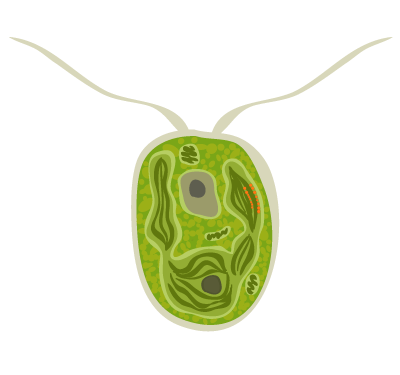
We aim a developing a microfluidic setup to immobilize, phenotype and select single-cell microalgae based on specific optical readouts (fluorescence, etc.).
Current fundings :
- ANR Phosphalgues (Coordinator) with L. Jullien (PASTEUR, ENS Chimie), A. Boulouis and S. Eberhart (IBPC) , F. Guyot (MNHN), G Charvin (IGBMC)
Functional lipid droplets as aAPCs
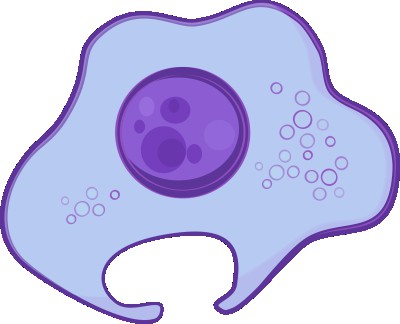
Functional emulsion droplets, engineered as artificial antigen-presenting cells with a fluid and deformable interface, enable precise force mapping during macrophage phagocytosis and B cell activation studies by mimicking the dynamic interactions that occur during cell encounter and uptake.
Current fundings :
- ANR Phagochemiforce with F. Niedergang (Institut Cochin, Coordinator), J.M. Mallet et Blaise Dumat (LBM, ENS Chimie)
- ANR Imperis with P. Pierobon (Institut Cochin, Coordinator), J.F. Rupprecht (Centuri Marseille)
Related references
[10] S. Michelis, C. Pompili, B. Dumat, F. Niedergang, J. Fattaccioli, J.-M. Mallet. FRET-sensing of receptor binding at the interface of targeted biomimetic microparticles functionalized with tunable fluorescent lipids \ ACS Applied Bio Materials (2024) URL
[9] J. Pineau, L. Pinon, J. Fattaccioli* , P. Pierobon* (2023). Functionalized Lipid Droplets and Microfluidics Approach to Study Immune Cell Polarity In Vitro. In: Baldari, C.T., Dustin, M.L. (eds) The Immune Synapse. Methods in Molecular Biology, vol 2654. Humana, New York, NY. DOI
[8] L. Pinon , N. Ruyssen , J. Pineau , O. Mesdjian , D. Cuvelier , R. Allena , S. Asnacios , A. Asnacios , P. Pierobon* , and J. Fattaccioli*. Phenotyping Polarization Dynamics Of Immune Cells Using A Lipid Droplet – Cell Pairing Microfluidic Platform.
Cell Reports Methods (2022) DOI
[7] J. Pineau, L. Pinon, O. Mesdjian, J. Fattaccioli, A.-M. Lennon-Duménil, P. Pierobon* . Microtubules restrict F-actin polymerization to the immune synapse via GEF-H1 to maintain polarity in lymphocytes.
eLife (2022) [DOI]
[6] B. Dumat‡, L. Montel‡, P. Matton, L. Pinon, L. Cattiaux, J. Fattaccioli*, J.M. Mallet*. Mannose-coated fluorescent emulsion droplets: specific biosensors for Mannose Receptor-induced phagocytosis.
ACS Applied Bio Materials., 2, 11, 5118-5126 (2019) [doi]
‡: equal contribution to the work
[5] L. Montel, L. Pinon, J. Fattaccioli*.
A multiparametric, quantitative and high-throughput assay to determine the influence of target size on phagocytic uptake.
Biophys. J., 117 (3) pp. 408-419 (2019) [doi]
Preprint available on BioRxiv (2019) [Link to BioRXiv]
[4] L. Pinon, L. Montel, O. Mesdjian, M. Bernard, A. Michel, C. Ménager, J. Fattaccioli*. Kinetically-enhanced fabrication of homogeneous biomimetic and functional emulsion droplets.
Langmuir, 34 (50), pp 15319–15326 (2018) [doi][url]
[3] D. Molino, S. Quignard, C. Gruget, F. Pincet, Y. Chen, M. Piel, J. Fattaccioli*.
On-chip quantitative measurement of mechanical stresses during cell migration with emulsion droplets.
Scientific Reports 6, 29113 (2016)[pdf][doi].
[2] S. Quignard*, G. Frébourg, Y. Chen, J. Fattaccioli.
*Nanometric emulsions encapsulating solid particles as alternative carriers for intracellular delivery.
Nanomedicine, 11 (16), 2059-2072 (2016) [pdf].
[1] K. Ben M’Barek, D. Molino, S. Quignard, Y. Chen, P. Chavrier and J. Fattaccioli*
Phagocytosis of Immunoglobulin-Coated Emulsion Droplets
Biomaterials 51, 270-277 (2015). [pdf][doi]
Degradable microcapsules from modified vegetable oils
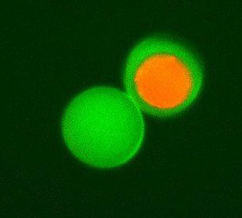
We aim at designing sophisticated and functional microcapsuls with degradable properties. We developed microfluidic devices for double emulsification and crosslinking.
Related references
Microfluidic trapping arrays
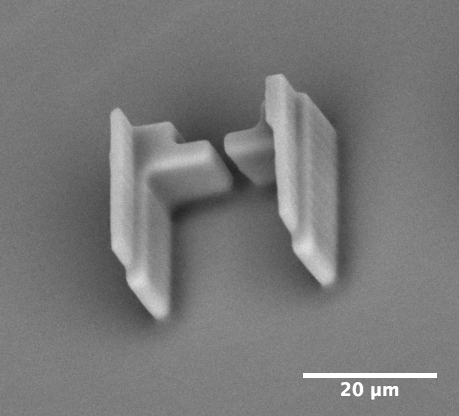
Microfluidic hydrodynamics trapping arrays are specialized micro-scale devices used to capture, isolate, and study individual cells, particles, or molecules in a controlled environment. Using precise fluid flows within microchannels, these arrays exploit the principles of hydrodynamic forces to trap and position objects without direct mechanical contact. By carefully manipulating flow rates and channel geometries, microfluidic hydrodynamic traps can achieve stable, repeatable positioning of targets, making them a versatile tool in biological research, as for example studies of the dynamics of the immune synapse.
Related references
[6] N. Ruyssen*, G. Fina, R. Allena, M.C. Jullien, J. Fattaccioli. \ Spanwise dispersion optimizes the efficiency of dense microfluidic trap arrays \ Arxiv (2024) Link \ Under review
[5] L. Pinon , N. Ruyssen , J. Pineau , O. Mesdjian , D. Cuvelier , R. Allena , S. Asnacios , A. Asnacios , P. Pierobon* , and J. Fattaccioli*. Phenotyping Polarization Dynamics Of Immune Cells Using A Lipid Droplet – Cell Pairing Microfluidic Platform.
Cell Reports Methods (2022) DOI (In press).
[4] O. Mesdjian‡, N. Ruyssen‡, M.-C. Jullien, R. Allena, J. Fattaccioli*. Enhancing the capture efficiency and homogeneity of single-layer flow-through trapping microfluidic devices using oblique hydrodynamic streams.
Microfluidics and Nanofluidics, 25, 91 (2021) [doi]
Post-review preprint avaiable on the ArXiv (2021) [url]
[3] K. Sakai, F. Charlot, T. Le Saux, S. Bonhomme, F. Nogué, J.C. Palauqui*, J. Fattaccioli*.
Design of a microfluidic and microscopic toolbox for the ultra-wide spatio-temporal study of plant protoplast development and physiology.
Plant Methods, 15, n° 19 (2019) [doi]
Preprint available on BioRxiv [Link to BioRXiv]
Highlighted in the french magazine La Recherche (Nov. 2019) [url][pdf]
Bacterial biofilms
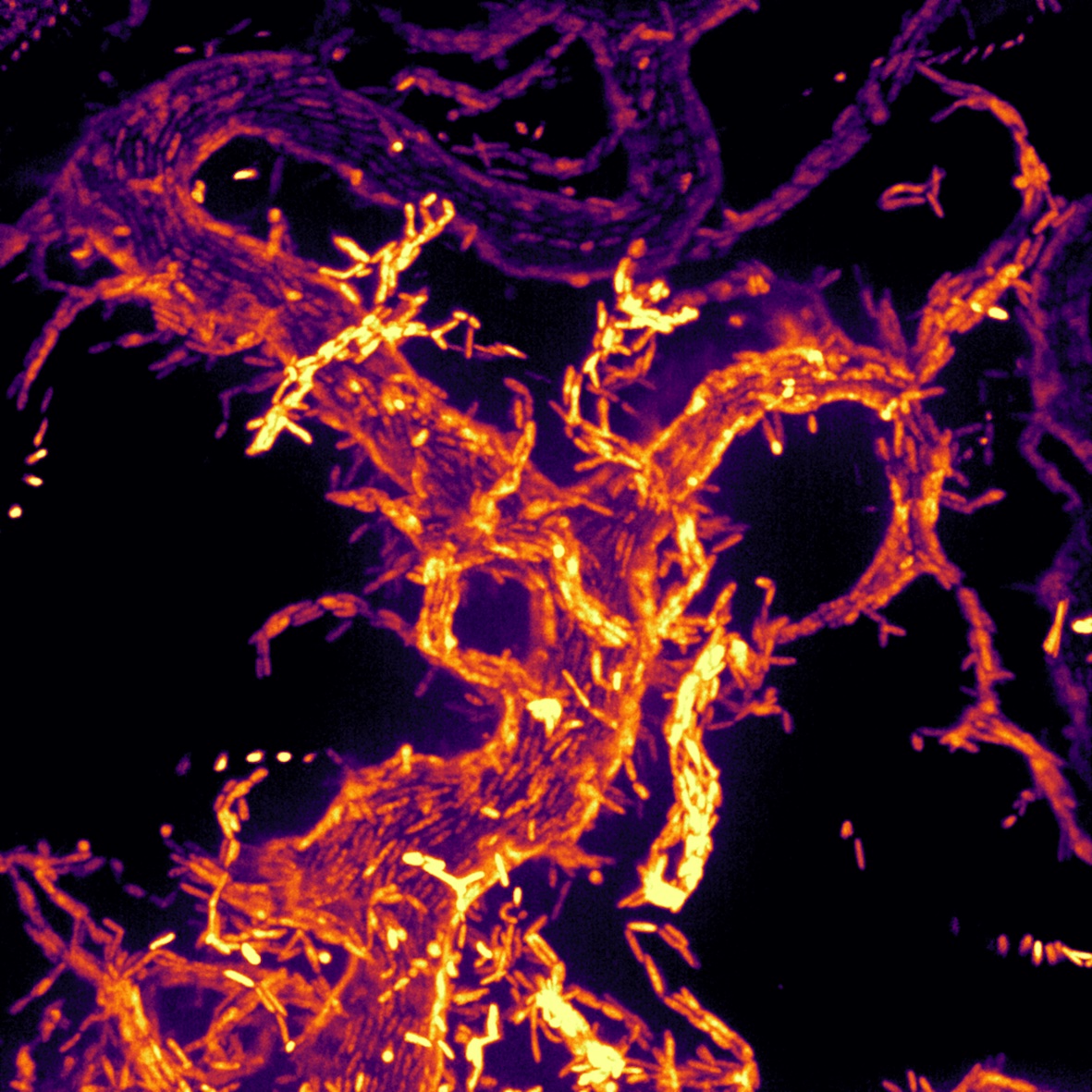
Alcanivorax, a genus of oil-degrading bacteria, plays a crucial role in breaking down hydrocarbons in oil-contaminated environments, making it invaluable for bioremediation efforts. These bacteria utilize the hydrocarbons in crude oil as a carbon and energy source, converting complex compounds into simpler, less harmful substances. Alcanivorax bacteria often form biofilms on oil surfaces, creating a structured community that protects them from environmental stress and enhances their metabolic capabilities. In collaboration with Andrew Utada (Tsukuba University, Japan), we study the dynamics of the biofilm and its impact on the oil consumption.
Related references
[2] M. Prasad, N. Obana, S.-Z. Lin, K. Sakai, C. Blanch-Mercader, J. Prost, N. Nomura, J.-F. Rupprecht*, J. Fattaccioli*, A. S. Utada*
Alcanivorax borkumensis Biofilms Enhance Oil Degradation By Interfacial Tubulation
Science (Accepted), 2023
BioRxiv (2022) 2022.08.06.503017; doi: https://doi.org/10.1101/2022.08.06.503017
[1] M. Prasad, N. Obana, K. Sakai, Y. Nakayama, S. Miyazaki, M. Toyofuku, J. Fattaccioli, N. Nomura, A.S. Utada*
Point mutations lead to increased levels of c-di-GMP and phenotypic changes to colony biofilm morphology in Alcanivorax borkumensis SK2.
Microbes and Environnements. 34 (1) pp. 104-107 (2019) [doi][pdf]
Plant development using microfluidic tools
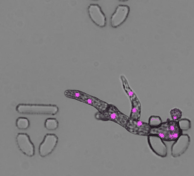
Microfluidics offers a powerful approach to studying plant development by enabling precise control over microenvironments, allowing researchers to monitor cellular responses, nutrient flows, and hormonal gradients in real-time under highly reproducible conditions. In collaboration with J.C. Palauqui (IJPB, INRAE Versailles), we developed a comprehensive experimental setup allowing the study of the development of the moss Physcomitrella Patens with an ultra-wide (from seconds to weeks, from single-cell to the complete organism) spatio-temporal resolution.
Related references
[1] K. Sakai, F. Charlot, T. Le Saux, S. Bonhomme, F. Nogué, J.C. Palauqui*, J. Fattaccioli*.
Design of a microfluidic and microscopic toolbox for the ultra-wide spatio-temporal study of plant protoplast development and physiology.
Plant Methods, 15, n° 19 (2019) [doi]
Preprint available on BioRxiv [Link to BioRXiv]
Highlighted in the french magazine La Recherche (Nov. 2019) [url][pdf]
Polydopamine and metal-coated microparticles
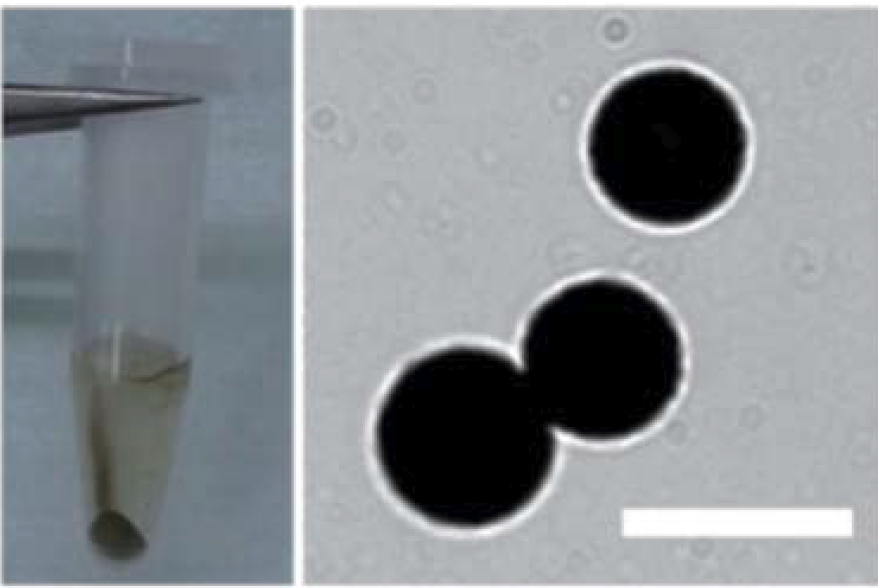
Polydopamine, a bioinspired polymer known for its strong adhesion to various surfaces, can serve as a versatile platform for metallization, enabling the deposition of metals like gold, silver, and copper, which enhances its applications in biosensing, catalysis, and antimicrobial coatings. Using emulsion droplets as a template, we showed that polydopamine could become fluorescent under UV illumination, and developed silver-coated liquid particles that we used as seed particles for micro-velocimetry.
Related references
[3] O. Mesdjian, Y. Chen, J. Fattaccioli*
Luminescent and Absorptive Metal-Coated Emulsions for Micro-Velocimetry
Microelectronic Engineering 158, 69-74 (2016). [pdf][doi].
[2] S. Quignard, Y. Chen, M. d’Ischia and J. Fattaccioli*
UV-induced fluorescence of polydopamine-coated emulsion droplets.
ChemPlusChem 79 (9), 1254-1257 (2014). [pdf][doi]
Article highlighted in Wiley-VCH Hot Topics – Surfaces and Interfaces. [link]
[1] G.M. Nocera, K. Ben M’Barek, D.G. Bazzoli, G. Fraux, M. Bontems-Van Heijenoort, J. Chokki, S. Georgeault, Y. Chen, and J. Fattaccioli*
Fluorescent microparticles fabrication through chemical coating of O/W emulsion droplets with a thin metallic film.
RSC Advances 4 (23), 11564 – 11568 (2014). [pdf][doi]